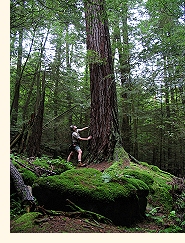The Pennsylvania Wilds is blessed with an incredible
array of old growth forests—forests that have never been harvested
or have only lightly seen the hands of man. An old growth driving
tour, navigating the Pennsylvania Wilds region, will take you to
some of these very unique areas, including the most exceptional old
growth of all, the trees found in Cook Forest State Park.
Cook Forest contains the finest stand of tall, aged
eastern white pine and eastern hemlock north of the Great Smoky
Mountains. Nine different old growth forest areas—covering over
2,200 acres—can be found within the boundaries of the park. Here,
28 pines tower more than 160 feet. Only four other living white
pines of such height can be found elsewhere in the commonwealth and
some of those reside in the nearby Heart’s Content Scenic Area of
Allegheny National Forest. There are only 16 pines in the northeast—outside
of Pennsylvania—that attain such grandeur.

Cook Forest also has three pines over 170 feet and
one pine stretching over 180 feet. This white pine, named the
Longfellow Pine, is the tallest tree in Pennsylvania, the tallest
known tree in the northeastern United States, and the fifth tallest
tree in the entire eastern part of the country! It’s not only tall
(183.6 feet) but broad (over 11.1 feet in circumference at breast
height or CBH). No wonder the “Forest Cathedral” is a registered
National Natural Landmark.
Cook Forest isn’t just home to lofty white pines.
It also contains 19 other trees of record size by species. Just to
name a few:
Seneca pine (12.6ft CBH x 173.2ft high) - largest in
overall dimensions in Pennsylvania
Seneca hemlock (12ft CBH x 145.4ft high) - tallest
known in the Northeast
Davies black cherry (11.4ft CBH x 137.3ft high) -
tallest known in the Northeast
American beech (7.5ft CBH x 127.5ft high) - tallest
known in Pennsylvania
White oak (10.7ft CBH x 127.3ft high) - tallest
known in the Northeast
Scarlet oak (8.2ft CBH x 120ft high) - tallest known
in the Northeast
Colorado blue spruce (5.1ft CBH x 115.7ft high) -
tallest known in eastern U.S.
American chestnut (3.7ft CBH x 84.2ft high) -
tallest known in the Northeast
Witch hazel (0.8ft CBH x 41.8ft high) - tallest
known in the Northeast
While some of the white pines and hemlocks at Cook
Forest are more than 300 years old, it also boasts of ancient
hardwoods. White oak has been found to exceed 350 years and a
cucumber tree was recently documented to over 450 years, a new
Eastern U.S dendrochronological record!

Within 45 minutes of Cook Forest are three of
Pennsylvania’s other premier old growth hemlock and white pine
sites: Heart’s Content Scenic Area, Tionesta Scenic and Research
Natural Area, and Anders Run Natural Area.
Heart’s Content, another National Natural
Landmark, is the second best place to see big hemlocks in the
Northeast. At 131 acres, it is much smaller than Cook Forest, but
still shows an exceptionally large array of ancient white pine and
hemlock.
Researchers from the Eastern Native Tree Society
recently documented one white pine here to be in excess of 900 cubic
feet. That could equate to over 11,000 board feet of wood in just
one tree! Heart’s Content has massive hemlocks as well. The “Heart’s
Content Hemlock” (13.9ft CBH x 126.6ft high) is currently the
largest single stem hemlock known in Pennsylvania by one system of
measurement.
The small Anders Run Natural Area, close to Warren
and the Buckaloons Recreation Area, displays several gorgeous pines.
The late state champ white pine was located here, dubbed the “Cornplanter
Pine” (13ft CBH x 167.7ft high). It is no longer alive.
For a truly remote wilderness old growth experience,
the Tionesta Scenic and Research Natural Area is the place to go. At
over 4,000 acres, it is the largest intact old growth forest in
Pennsylvania. Hemlocks more than 500 years old have been documented
here.
Trek miles into the wilderness—off of forest
service roads (not accessible during winter and early spring)—to a
place devoid of cars and other man-made sounds, but full of big
trees, gentle and giant. This area was devastated by the 1985
derecho that resulted in multiple tornados ripping across the state
causing numerous deaths and, years later, by the same winds that
took down the Kinzua Viaduct. Beech bark disease has also ravaged
this site resulting in yet another major canopy opening event.
Tionesta is in a state of recovery and transition, but old growth
forests are notoriously resilient. As long as the genetics are
retained and human pressures are kept at a minimum, they can
recover.
Get out and enjoy these incredible old growth forest
stands in the Pennsylvania Wilds. Some were here before
Christopher Columbus founded the new world. Many witnessed the birth
of our nation. Imagine what you would see standing in place for 500
years. Pennsylvania’s history is written in its trees. It’s up
to us to discover it.